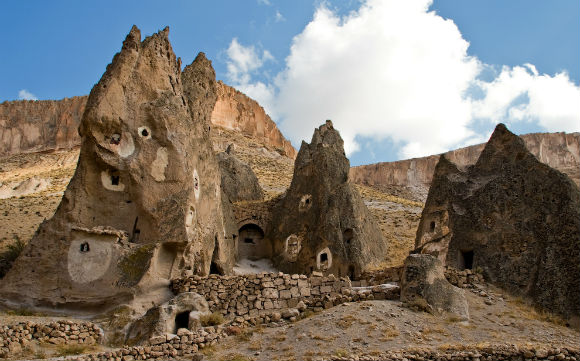The Snake Church is surrounded by several rooms in the rock, including the refectory which is adjacent to the church, and several others above. The church itself is a long, narrow room divided into two different sections. Immediately after the entrance, the left wall bears a niche. To the right of the entrance, the upper part of the vault portrays three saints, including St Thomas and an interesting St onofrio in the nude. However local legend has it that St onofrio originally belonged to Snake Church) is a simple barrel-vaulted church with a low ceiling and long nave. It is named for the frescoe of Saints Theodore and St George slaying the dragon (or snake as depicted in the frescoe). The church also has a frescoe of Emperor Constantine and his mother Saint Helena depicted holding the “True Cross.” Legend has it that she discovered the cross upon which Jesus was crucified after seeing it in a dream, and that a piece of the cross is still buried in the foundations of the Hagia Sophia in Istanbul. Other sections of the cross are in the Church of the Holy Sepulchre and in St. Peter’s in Rome. Another interesting portrait is the one of Saint Onuphrius on the upper wall to the right of the entrance. The saint lived the life of a hermit in the Egyptian desert near Thebes, Egypt and is usually depicted with a long gray beard and wearing only a fig leaf.
A simple barrel-vaulted church with a low ceiling and long nave, it is the name for the fresco of Saints Theodore and St George slaying the dragon (or snake as depicted in the fresco).
The church also has a fresco of Emperor Constantine and his mother Saint Helena depicted holding the “True Cross.” Legend has it that she discovered the cross upon which Jesus was crucified after seeing it in a dream, and that a piece of the cross is still buried in the foundations of the Hagia Sophia in Istanbul. Other sections of the cross are in the Church of the Holy Sepulchre and in St. Peter’s in Rome.
Another interesting portrait is the one of Saint Onuphrius on the upper wall to the right of the entrance. The saint lived the life of a hermit in the Egyptian desert near Thebes, Egypt and is usually depicted with a long gray beard wearing only a fig leaf.
Arcitecture of Snake (Yilanli) Church ;
This church has a linear plan, consisting of two chambers. The front section is barrel-vaulted, while the back one has a flat ceiling. The red ochre ornaments imitate hewn stone plait. Frescoes dated to the 11th century, are painted directly on the wall. Opposite the entrance, there is an image of Christ with a book in his hand, and at his left, on both sides of a large cross, are Emperor Constantine and Helena. Right next to it, the Killing of the Snake by St. George and St. Theodore is depicted. On the opposite wall, Onophrios can be seen with a sapling in front of him, also the Apostle Thomas, and the founder of the building, St. Basileios holding a book in one hand and sanctifying with the other.
The Yilanli Kilise is surrounded by several rooms in the rock, including the refectory which is adjacent to the church, and several others above. The church itself is a long, narrow room divided into two different sections. Immediately after the entrance, the left wall bears a niche. To the right of the entrance, the upper part of the vault portrays three saints, including St Thomas and an interesting St Onofrio in the nude. However local legend has it that St Onofrio originally belonged to the female sex, but that God made her into a man to keep her away.
The Snake Church (Yılanlı Kilise),




The Snake Church has a long nave with a low, barrel-vaulted ceiling.
Among the frescoes are portraits of St. Theodore, St. George slaying the dragon again (it looks like a snake, for which the chapel is named.)
The Snake Church, with Snake on Left.
This small tomb-church consists of a long vaulted nave and a low ceiling. Across the entrance, a Christ figure with the founder of the chapel has been depicted in fresco form. On the right wall we see St. Basil and St. Thomas. Close to them is St. Onouphrios, the hermit, whose genitals were hidden by foliage.
According to the legend, this female saint was changed into a man. On the left wall Saint Theodore is shown struggling with the snake (the name of the church derives from this) and Emperor Constantine and his mother Helen are shown supporting the cross in their hands.